Advanced Search Map Locator
View Settings
About Calscape Nurseries
California Garden Planner Bay Area Garden Planner (NEW) Planting Guide
Butterflies My Plant Lists
Contact Calscape Donate

Calscape California Native Plant Gardening Guide
The Nature Restoration Approach
Calscape is focused on helping Californians restore nature one garden at a time. We believe that nature is the most beautiful and environmentally responsible model for landscaping in California. And even more importantly, we believe that homeowners restoring nature in their gardens can slow and one day even reverse the loss of biodiversity being caused by rampant development in California. This guide is meant to give native plant gardeners and other small-scale nature restorers the information they'll need to do that by mimicking nature in their plant selection, irrigation, mulching, weed control and pest control practices.
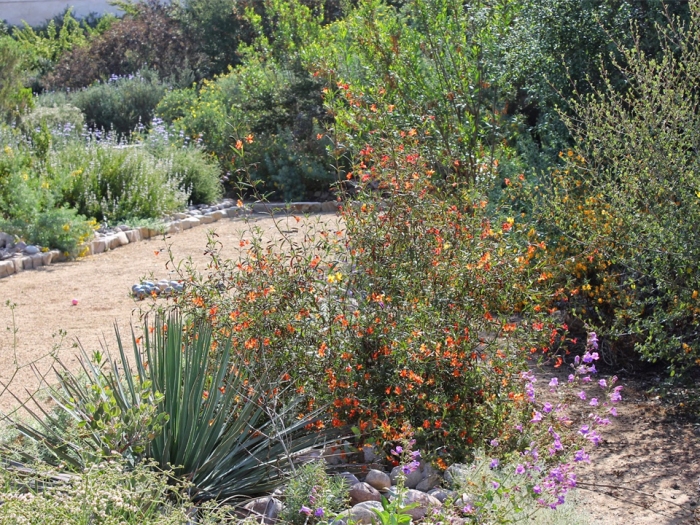
Biomimicry Plant Selection
The single most important factor in nature restoration gardening is choosing native plants that would naturally occur where you are planting them.
Choosing Plants for your Climate
California is a state of extremely diverse climates. Annual precipitation ranges from under 3" per year in desert areas to over 150" per year in the temperate rain forests in northern California. Precipitation levels can change dramatically even from one square mile to the next, especially at different elevations. Rainfall patterns, length of drought period, high and low temperatures, and wettest and driest humidity levels can also vary greatly across the state even within small areas. Different California native plant species evolved to handle these different conditions.

Because of this, it's important to pick the right plants for the area where your garden is located. Native plants are easier to grow, healthier and require little or no artificial irrigation when they are planted in an area in which they evolved and naturally belong. "California natives" that aren't really native to your location will often struggle or die no matter how much you water them. This is especially true because direct summer irrigation often kills California natives.
To find plants native to your area, just type your address or city into the address window in the Calscape home page. For example, if you enter "California Native Plant Society, 2707 K Street, Sacramento, CA", Calscape will search through the over 7,000 plants native to all of California to show you the 425 plants that are likely native to that location, all organized by landscaping popularity, plant type, sun conditions, water requirements, and ease of growing and other categories.
While you should start with the plants that naturally grow in the climate of your location, keep in mind that they also need to be placed in spots in your garden with the appropriate drainage, soil moisture and sun conditions.
Choosing Plants for Your Drainage Conditions
While most native plants are adaptable to a variety of soil types, they tend to have much more specific requirements when it comes to rainy season drainage. For example, many California native plants won't tolerate standing water for any length of time. They'll die from either root rot or suffocation as saturated soils prevent oxygen from getting to plant roots. Such plants need to be planted in either fast draining sandy or loamy soils. Or if in slow draining clay soils, they'll need to be on slopes where water is unlikely to saturate the ground around the plant. Use the Calscape Advanced Search tool to see which plants tolerate fast, medium and slow draining soils and site them accordingly in your garden.
Choosing Plants for Your Soil Moisture Conditions
California native plants have different requirements when it comes to retained soil moisture during the dry season. In California, most soils are naturally quite dry during the summer and early fall months. However, riparian spots can be moist year-round. Semi-riparian spots near water sources retain more soil moisture than the surrounding area in the dry period. Other topologies like slope bottoms and north facing slopes also tend to hold more moisture than average through the dry period. Certain California native plants evolved to grow in these different moisture niches, and you need to make sure you are siting your plants to put them in the niche they require. For example, if you try to grow a native plant that evolved to grow in a moist canyon bottom on the top of a dry slope, it will likely die.

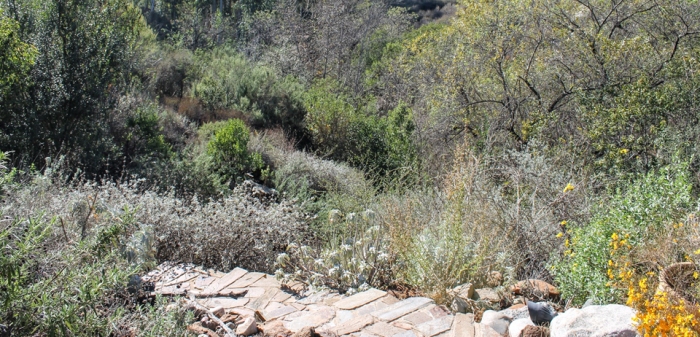
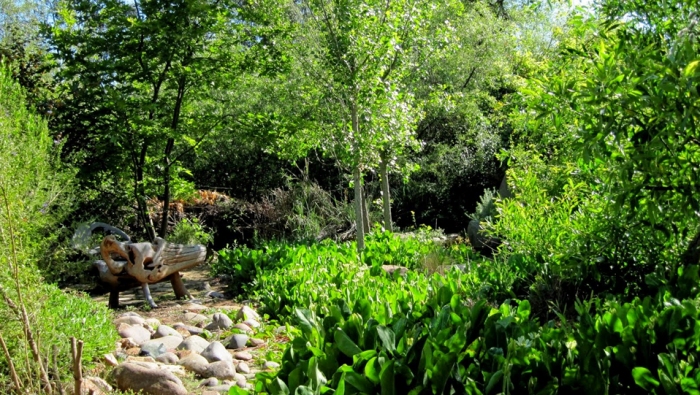
Use Calscape to make sure you are placing your plants in spots with appropriate soil moisture. Use extremely low water plants for drier than average conditions typically found in south facing and upper slopes. Use very low water plants in areas with normal moisture levels for their area, like east and west facing slopes and flats. Use low water plants in areas that have more soil moisture than average like north facing slopes, canyon bottoms or areas not far from seeps, creeks or other water sources. Use moderate to high water plants for year round moist soils, such as riparian zones or areas in or immediately adjacent to seeps, creeks, or regularly irrigated areas.
Choosing Plants for Your Sun Conditions
Most California natives also have specific requirements for the level of sun or shade they can tolerate. We recommend that you survey your garden space to understand which areas are sunny all day, which ones are sunny part of the day, and which ones are shady most or all day. Use Calscape to see which plants require full sun, part shade or full shade and site accordingly within your garden.
Overall Plant Selection
Use Calscape Advanced Search to choose plants that match all these factors and more. For example, you can select plants native to 2707 K Street, Sacramento CA, that tolerate full sun, fast draining soils and above average soil moisture. You'll then be shown the 50 plants plants that match on all those factors. You can also use the tool to find which plants match the type you want (i.e. shrubs, trees, grasses), which are best for a particular use, (i.e. groundcover), which are easiest to grow, and which ones are available at your local nursery.
Installing New Plants
For best results, plant in late fall, winter, or early spring. Hot summer or early fall conditions are a difficult time to start most non-riparian plants. It's usually best to start with 1 gallon plants. Within 2-3 years after planting they'll be as big as the plants that started out in 5 gallon containers. Root-bound plants should not be planted as they will never develop a healthy root structure and are not likely to live long.
When putting your plants in the ground, dig a square hole that is twice as wide and half again as deep as the container. (Square holes prevent the roots from wrapping after planting.) If planting on a dry bank or slope, it's best to create a flat area around the hole too, at least twice the diameter of the hole. It'll help the new plant retain just a bit more water. If the soil is very dry, fill the hole with water and let it soak through before continuing. Rough up the sides and bottom of the hole so the roots will be able to dig in as they grow. Put back enough loose dirt in the bottom of the holes, so that when you put the plant in the hole, the root ball is about 1/2" higher than the surrounding grade.
Don't rough up the roots of native plants when you take them out of the container. It's best to leave their roots as undisturbed as possible. Tamp loose dirt gently into the gap around the plant, but don't push down on the root ball itself.
Put rocks and/or organic mulch around the plant to shade its roots and help the new plant get started. Rocks are best since they don't soak up any water, won't block air flow, and won't wick moisture away from the soil. If you use organic mulch like shredded bark, just put down a light and thin (~2-3") layer. Much more than this will soak up too much rainwater and prevent it from it from passing through to the plants. Light airy organic mulches are better than heavy ones. Heavy organic mulches tamped down on the soil will soak up rainwater, wick moisture away from the ground and dry out the soil. It can also interrupt proper air flow to the roots. Place your rocks and/or mulch on the exterior half of the root ball and extend out about a foot. Don't cover the interior half of the root ball, or the plant won't be able to breath properly. Over time, the plant will create its own preferred organic mulch by dropping leaves.
Watering New Plants
Once the plant is in the ground, generously soak it. The initial soaking is probably the only time you can't water most native California plants too much.
It's important to keep the root ball moist but not soggy during the first three months after planting. During the rainy season, you might not have to water at all, but if there's no rainfall after planting, you'll probably have to water 1-2 times per week during this period. After the first three months, start less frequent, but deeper watering. Make sure the root ball is only slightly moist before each new deep watering, usually every 2-3 weeks if there's no rain. Then give it a good soaking. During the rainy season, you can usually rely mostly or entirely on natural rainfall.
After the plant has doubled in size (usually after 1-2 years) the plant should be fairly-well established. If the plant is properly sited, you should be able to cut back watering to once per month or stop direct watering entirely then. Direct irrigation tends to slow root development since plants have no reason to stretch out their roots much to find water. Moderate drought stress encourages broad and deep root development over time. The more extensive the root system, the healthier the plants will be and the more likely they’ll be to make it through the dry season without artificial irrigation.
After 2 years, it’s best to avoid direct irrigation of non-riparian plants as much as possible.
Watering Established Plants / Biomimicry Irrigation
Irrigating established California native plants in the summer can be tricky. Even 1x/month direct watering in the dry season can sometimes kill established California native plants and often shortens their lives. Why don't traditional irrigation methods work well with established California natives? The primary reason is that warm and wet conditions often kill the mycorrhiza that drought tolerant California natives depend on.
So what is mycorrhiza? Basically, mycorrhiza is a wonderfully sophisticated fungus that lives symbiotically in the roots of plants. In exchange for carbon from the plant leaves, mycorrhiza provides critical micronutrients to its plant hosts and increases the absorptive capabilities of California native plant root systems by up to 1000x. It also acts as a sponge by storing water and making it available to plants in dry periods. It even secretes chemicals necessary to repress weeds and kill soil pathogens. Nearly all non-riparian California natives need healthy mycorrhiza to survive. The older the plant, the more dependent it becomes on mycorrhiza, and the more likely it is to die if the mycorrhizal fungus in the soil dies or is damaged. Note that any native plant you buy from a nursery will come inoculated with native mycorrhiza. It will extend out through your garden along with the native plant roots.
So why does direct summer irrigation often kill mycorrhiza? Over 95% of Californians live in areas where little or no rain falls from late spring through the early fall. Because of this, the mycorrhiza species native to these areas have never evolved to handle warm wet conditions. Unfortunately, the bacterial pathogens that kill mycorrhiza do thrive in such conditions. So whenever you provide a significant amount of water directly to drought tolerant California natives during the naturally hot and dry months of the year, there is a risk that it'll cause a bacterial bloom in your soil that will kill your mycorrhiza and your plants.

Shouldn't native plants be able to survive on only rainfall? In most developed areas of the state, natural drainages have been paved over, creeks channeled to culverts, and slopes flattened. So many gardens are not getting the same amount of soil moisture from runoff that they would naturally. Because of this, many native plant gardeners will find it difficult to grow plants that evolved near drainages, or on slope bottoms or north slopes, even if they historically grew around their location. These are often the most beautiful plants and tend to support the greatest biodiversity. Additionally, it can be dangerous to allow your native plants to become too drought stressed near your house, particularly in fire prone areas. So many native plant gardeners will wish to add just a bit of water into their landscape.
The best solution to this problem is to mimic natural irrigation systems by using the root systems of native plants to transport water from moister areas to drier areas. Mycorrhiza seem to have no problem with this kind of subterranean natural irrigation system. There are two main types of biomimicry irrigation
Pulling moisture laterally from surface water sources
In nature, the most beautiful, summer verdant natural areas in California often have a creek or other water source nearby. The area stays greener because the interconnected roots of nearby plants pull moisture up and out from the water source and into the drier areas. Riparian plants stretch their roots down to the water source and pull it up the bank. Semi-riparian plants then pull water up from the riparian plants, and dry soil plants pull moisture up-hill from there. Horizontal roots are often very extensive. Riparian plants such as Willows and Cottonwoods can have roots over 100 feet wide. Semi-riparian plants like Coast Live Oaks can have roots up to 200 feet wide. Manzanita roots have been measured at around 20 feet wide, and Ceanothus, Mountain Mahogany and Chamise and Toyon at around 10 feet wide. Even coastal sage scrub plants like white and black sages can have root systems up to about 8 feet wide.
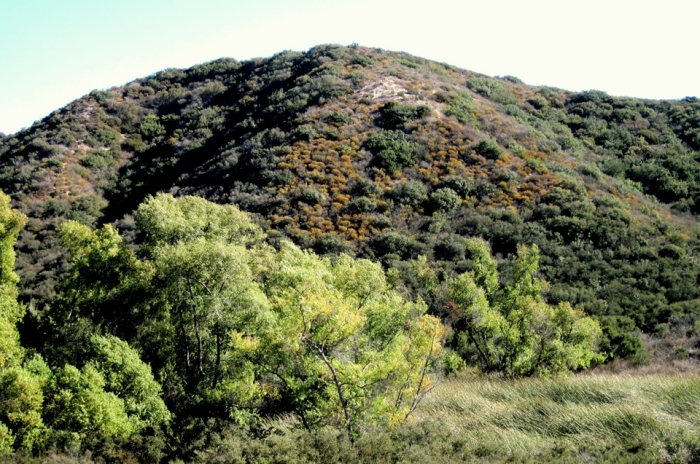
Native plant gardeners can mimic this system by creating irrigated bioswales, catch basins and troughs that collect rainwater and hold water from irrigation. In fire prone areas, it's also a good idea designate the strips immediately adjacent to your house as areas to keep moist. Saturate your designated irrigated areas once per week in the dry season with bubblers, soakers or targeted sprinklers. Watering in this manner for 10 minutes a week should be enough. Plant riparian /moist soil plants in or adjacent to these moist irrigated areas. Non-riparian plants can be planted as little as 3 feet away from the edge of the irrigated areas. You can also space out plants to pull moisture much farther from the irrigated areas, so that the moisture is transported away from the damp soils and riparian plants, to semi-riparian or low water plants, to very low water plants, and eventually to extremely low water plants. Plant root systems can grow 3-5 feet per year if water stressed. Roots will grow directionally towards the water source, and closely spaced plants will lock into a mycorrhizal water-sharing root grid in 1-2 years. As a rough rule of thumb, California native plant root widths average around 3x the width of the crown, though the real widths will vary dramatically depending on soil type and proximity to moisture as well as by species. Plants in loam or sandy soils will tend to have more extensive root systems, especially if they are stretching to water. Plants in hard clay soils will tend to have smaller root systems.
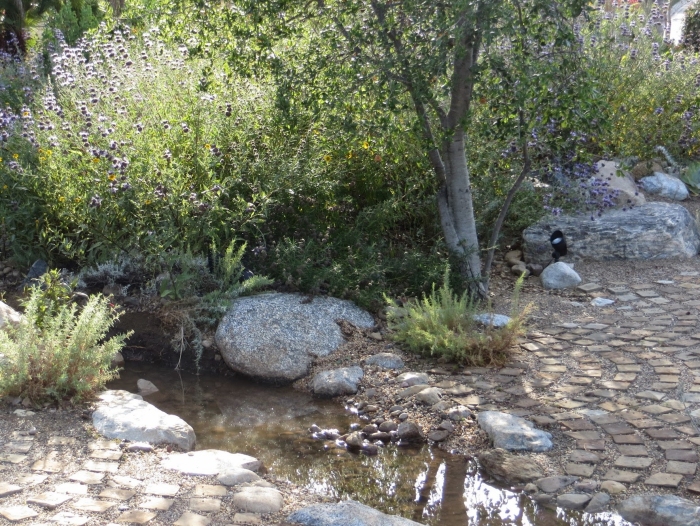

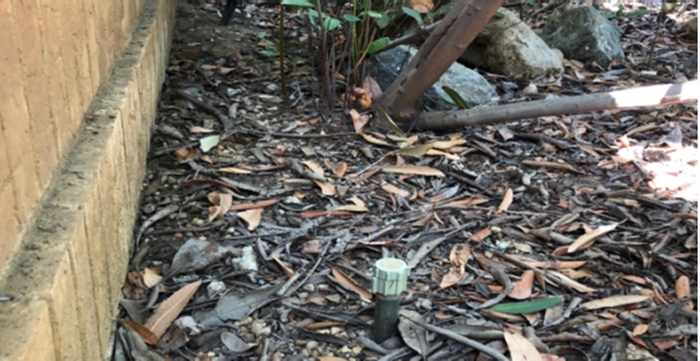
Pulling moisture up from underground water sources.
Deep rooted plants also pull moisture up from the water table and other underground water sources and share it with the shallower rooted plants. Some known deep rooting California native plants have been measured with roots at the following depths: Blue Oak at 80 feet, Interior Live Oak at 70 feet, Engelman Oak at 65 feet, Laurel Sumac at 50 feet, Coast Live Oaks, Black Oak, Big Saltbush at 40 feet, Scrub Oak at 30 feet, Sugar Bush, Lemonade Berry and Valley Oak at 25 feet, Canyon Oak and Eastwood Manzanita at 20 feet, Ceanothus leucodermis and Rabbitbrush at 15 feet, Big Basin Sagebrush, Coyote Brush, Bigberry Manzanita and Ceanothus oliganthus at 10 feet, and Toyon (sometimes considered a deep root plant) at 7 feet. Large trees can deliver up to 40-60 gallons of water to upper soil layers every night. Smaller shrubs can deliver up to a quart of water to surface soils each night. Measurements of arid ecosystems of North America show that shallow root grasses get 20-50% of their moisture from water that is lifted by deep rooted sagebrush shrubs. (Dawson 1993).
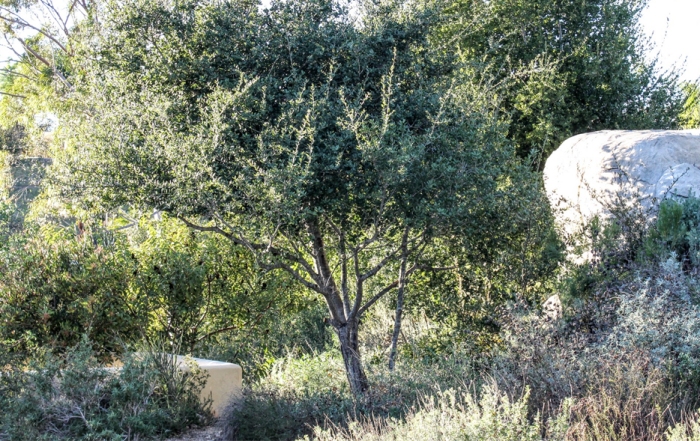
Native plant gardeners can bring a substantial amount of moisture up from the water table and other deeper groundwater reserves by interspersing deep root trees and shrubs like the ones shown above around their landscape. Oaks are probably the single best plants that support these natural irrigation systems given their deep and wide root networks. Once the moisture is lifted to the surface soil, it will be shared laterally across the grid of interconnected plant roots and mycorrhiza. The more extensive the root system of your plants is, the healthier your garden is likely to be.
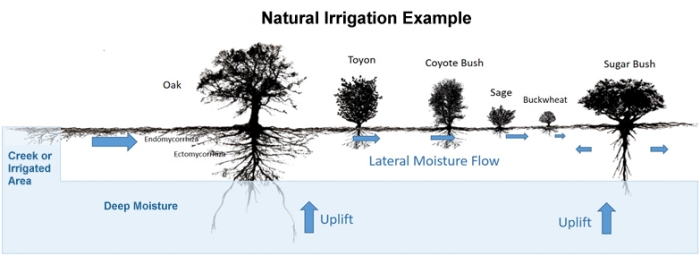
By employing these two techniques you can keep your native plant gardens more verdant year-round, you can often grow a wider range of locally native plants and it will support a much greater range of biodiversity than would otherwise be possible.
Biomimicry Mulching / Reducing Evaporation Rates
While almost all native plants do better with some rocks placed over their roots, once they are established, it's usually best to let established natives them make their own organic mulch by dropping their leaves. Native plants naturally evolved to grow in their own organic mulch. So it's best to mimic that system as much as possible. Leaf litter from natives tends to be light and airy, and allows oxygen down into the roots, doesn't soak up water, but still shades the roots which slows the rate at which water evaporates from the soils.
You'll also slow soil evaporation by placing your plants somewhat closer together, so that branches of adjacent plants touch after 2-3 years, and most of the soil is shaded by their leaves. An additional advantage of more closely spaced plants is that intermeshed plant roots encourage more extensive mycorrhiza growth, overall better soil quality, larger root systems and subterranean moisture exchange between plants. Natural areas with high percentage of plant coverage tend to be greener and healthier in part for this reason.
Native plants even in poor soils usually get all the organic material and fertilizer they need from their own leaf litter, so avoid adding fertilizer that will throw the natural soil chemistry out of balance. It's also important to note that very fast-growing trees and shrubs tend to have softer, less dense plant tissue that is more easily invaded by pathogens. So adding fertilizer to your soil might also make your plants grow too fast and become susceptible to disease. Be patient, let nature take its course, and your plants will be much longer lived.
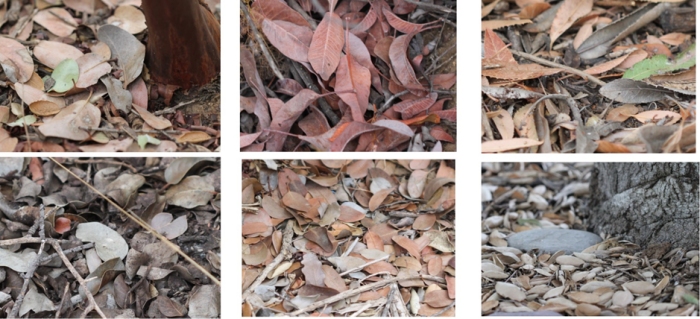
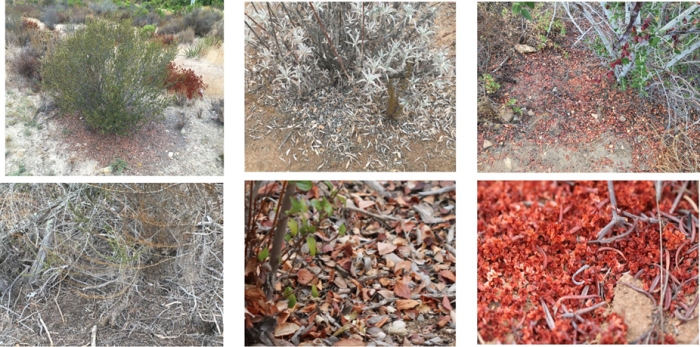
Biomimicry Weed Control
Unlike in most gardens, undisturbed natural areas rarely have weeds There are two main reasons for this. First, undisturbed natural areas get no artificial irrigation. Most invasive weeds never evolved to be able to handle the arid conditions of California's dry season. Second, healthy mycorrhiza in a native plant garden is amazingly effective at killing weeds. Mycorrhiza secretes chemicals that repress weeds. It is even able to restrict critical micronutrients from weeds roots and only share them with their allied native plants! As your native plants fill in and roots interconnect, you'll have mycorrhiza throughout your garden, and fewer and fewer weeds. To use this natural system of weed control, use the techniques described earlier to promote healthy mycorrhiza and dry summer soils in the rest of your garden.
Make sure to pull out any weeds that pop up before your mycorrhiza is established, particularly in the rainy season. Weeds are not defenseless. They secrete chemicals that kill the mycorrhiza. So it's important to give the mycorrhiza the advantage or it may never get established. In the life and death battle between weeds and mycorrhiza in a new native garden, make sure the mycorrhiza win. In the parts of your garden with dry summer soils and healthy mycorrhiza, you'll likely have few if any weeds after a few years. If you decide to add a few designated riparian / regularly irrigated areas, you'll likely always have to occasionally pull weeds by hand in those spots. Make sure to pull any weeds you see before they seed.
Avoid disturbing the soil as much as possible. Disturbed soils attract weeds. And very importantly, avoid using Roundup. It will kill your mycorrhiza and end up increasing the number of weeds you'll need to deal with.
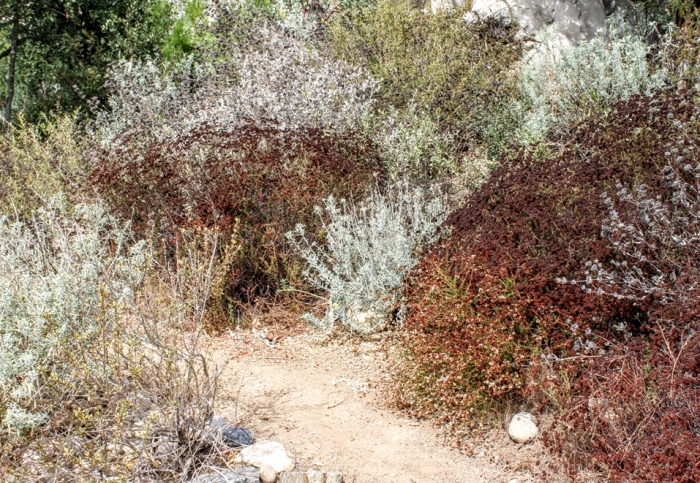
Biomimicry Pest Control
Controlling Insects: People with native plant gardens start to think a different way about insects. When an ecosystem is in balance, you'll see the native insects you used to think of as pests instead as critical parts of the ecosystem. The relationship between native plants and native insect herbivores is a pillar of the food chain in most natural terrestrial environments. And critically, 90% of insect herbivores evolved to eat the leaves of just a small number of plant species native to their geographic range, sometimes in just one genus of plants. These plants are called "host plants" for insect herbivores. (See California native butterfly host plants for examples.)
Non-native plants can seldom be host plants for native insect herbivores because few can get past the chemical and structural defenses of other than a handful of the native plants with which they coevolved. If a given species of insect herbivore cannot find their particular host plants in an area, it will die out in that area. Terrestrial birds, predator/beneficial insects, reptiles, amphibians and many mammals depend either directly or indirectly on these native plant - insect herbivore pairs. For example, 96% of terrestrial bird species rely on insects to feed their young, so if the required native plants are not present in an area, the insect herbivore species will die out in that area along with the birds that depend on them. For more information, read "Plant Choice Matters", excerpted from Nature's Best Hope by University of Delaware Professor of Entomology Doug Tallamy.
To keep insects under control, try to mimic the natural environment with an ecology that is in balance. It all starts with selecting native plants that naturally belong where they are being grow. They are better able to tolerate native insect herbivores because they co-evolved with them. These native insect herbivores might eat a few leaves from their native plants, but they will seldom really hurt them. Even aphids seldom seem to do real damage to endemic natives. This is in part because larger populations of insect herbivores will attract numerous types of "beneficial" predatory insects, as well as birds, bats and reptiles that will help keep the system in balance. A single bat can eat over 6000 insects per night, a single hummingbird can eat over 1000 insects per day, and single swallow can eat over 700 insects per day. But because insect biomass is so great (about 500 times greater than bird biomass), predatory insects are still more important than birds or bats for controlling insect. Spiders alone eat more insects than all bird species combined, consuming as much as 800 million tons of insects around the world every year.
Amazingly, when even a single plant is under stress from insect herbivores, that plant as well as other nearby plants send out coordinated chemical signals that attract insect predators. This is one of the reasons that while native plant gardens have more insect biomass than non-native gardens, they tend to have fewer insects that cause problems for humans. The populations of the few insect species that bother people (like mosquitos, flies and gnats) are kept under control by the predators that were attracted by the larger populations of native insect herbivores.
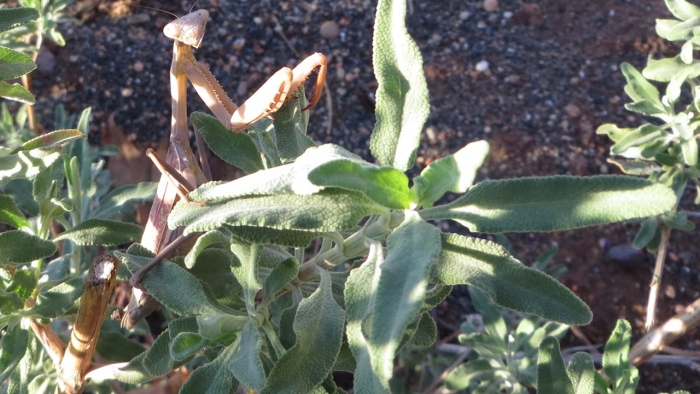
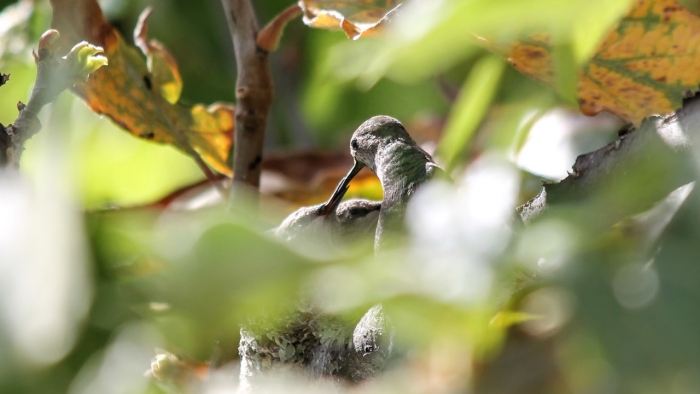
Most importantly, avoid all pesticides. They'll destroy the native plant / insect herbivore relationship that is so critical to developing a working ecosystem in your garden.
Controlling Rodents: Rabbits, squirrels, wood rats and mice can be a problem especially in new gardens. If rodents are eating newly planted native plants, you may need to put a chicken wire cage around them. Fortunately, while rodents may trim back plants significantly, they seldom kill locally native plants after they've been in the ground a month or two, and they provide needed nitrogen for the soil in exchange for the leaves they eat. Eventually your rodents will attract raptors and other predators that will keep their population in balance. Owls and hawks are particularly common in native plant gardens. One adult owl or hawk will eat about 100 pounds of rodents every year. If you want raptors you need rodents! Avoid using poison in particular. It will make its way from the rodents to the predators, and prevent your garden ecology from getting into natural balance.

Controlling Diseases: Biomimicry disease control basically calls for growing plants that naturally belong in the area you planted them in, growing them in the conditions in which they evolved, and keeping your mycorrhiza healthy. California native plants surrounded by healthy mycorrhiza seem to have amazingly strong defenses against diseases. Native plants surrounded by healthy mycorrhiza are usually able to fight off mildews, rusts, and pathogens entering wounds. Mycorrhiza appears to be the key here. Amazingly, mycorrhiza secretes chemicals which keep soil-borne bacteria in balance, and control soil pathogens and other harmful organisms. It even appears to inoculate plants against above-ground diseases. So it's critical to avoid things that can kill your mycorrhiza, especially warm weather irrigation. Warm weather irrigation that kills your mycorrhiza will also destroy the natural immune system of your garden. Avoid chemical fertilizers which will also throw native plant ecology out of balance.
Summary
The nature restoration approach to native plant gardening may sound complicated, but in this approach, nature does all the work. It simply involves selecting plants that belong where you are planting them, perhaps adding a bit of water to a few small irrigated areas in the dry season, pulling a gradually diminishing number of weeds, and then letting nature do the rest. When it comes to native plant gardening in California, less is more. It's the best formula for growing healthy, long-lived California native plants, and supporting nature in the developed parts of California. As your ecosystem builds and gets into balance, you'll be amazed at the diversity of life that your garden will support, especially if you grow a variety of different native plant species, including trees, shrubs, perennials and annuals. Native oaks are probably the single best plant genus for supporting biodiversity in a garden.
A California native plant garden in natural balance can be amazingly beautiful, with a diversity of bird, butterfly and other pollinator life that rivals that of wild areas, and makes traditional gardens seem sterile in comparison. There is no garden as beautiful as nature.








